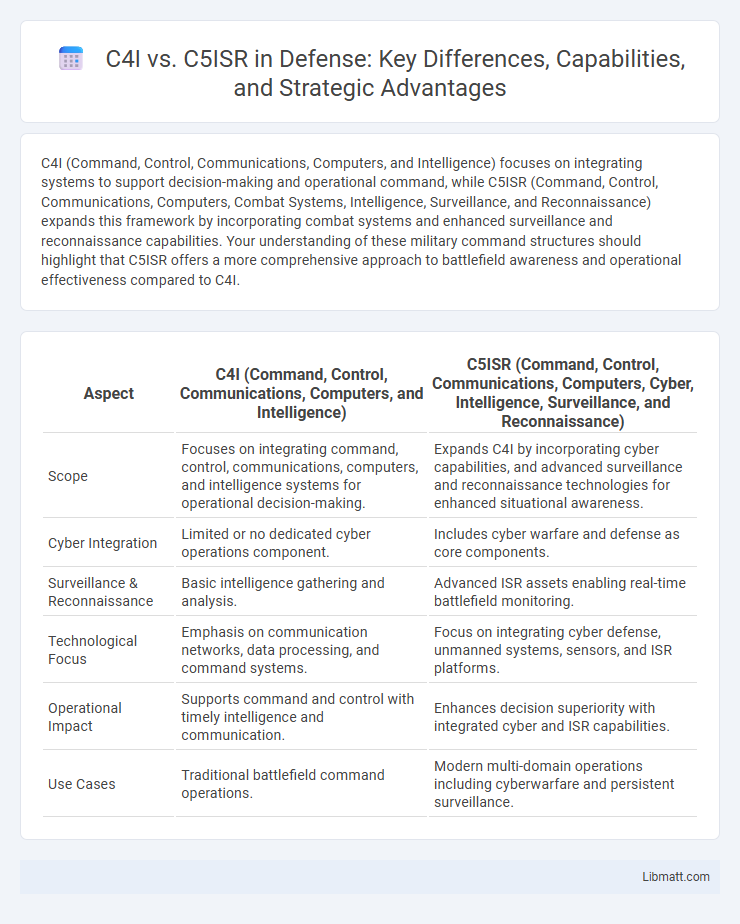C4I (Command, Control, Communications, Computers, and Intelligence) focuses on integrating systems to support decision-making and operational command, while C5ISR (Command, Control, Communications, Computers, Combat Systems, Intelligence, Surveillance, and Reconnaissance) expands this framework by incorporating combat systems and enhanced surveillance and reconnaissance capabilities. Your understanding of these military command structures should highlight that C5ISR offers a more comprehensive approach to battlefield awareness and operational effectiveness compared to C4I.
Table of Comparison
| Aspect | C4I (Command, Control, Communications, Computers, and Intelligence) | C5ISR (Command, Control, Communications, Computers, Cyber, Intelligence, Surveillance, and Reconnaissance) |
|---|---|---|
| Scope | Focuses on integrating command, control, communications, computers, and intelligence systems for operational decision-making. | Expands C4I by incorporating cyber capabilities, and advanced surveillance and reconnaissance technologies for enhanced situational awareness. |
| Cyber Integration | Limited or no dedicated cyber operations component. | Includes cyber warfare and defense as core components. |
| Surveillance & Reconnaissance | Basic intelligence gathering and analysis. | Advanced ISR assets enabling real-time battlefield monitoring. |
| Technological Focus | Emphasis on communication networks, data processing, and command systems. | Focus on integrating cyber defense, unmanned systems, sensors, and ISR platforms. |
| Operational Impact | Supports command and control with timely intelligence and communication. | Enhances decision superiority with integrated cyber and ISR capabilities. |
| Use Cases | Traditional battlefield command operations. | Modern multi-domain operations including cyberwarfare and persistent surveillance. |
Introduction to C4I and C5ISR
C4I (Command, Control, Communications, Computers, and Intelligence) systems integrate military operations by enabling real-time information exchange and decision-making support. C5ISR (Command, Control, Communications, Computers, Cyber, Intelligence, Surveillance, and Reconnaissance) expands on C4I by incorporating cyber capabilities alongside enhanced surveillance and reconnaissance functions. This evolution addresses modern warfare complexities with comprehensive situational awareness, secure communications, and cyber defense integration.
Defining C4I: Core Components
C4I, standing for Command, Control, Communications, Computers, and Intelligence, integrates essential military functions that enable effective decision-making and operational execution. Core components include command and control systems for strategic leadership, communication networks ensuring real-time data exchange, advanced computing platforms for data processing, and intelligence operations gathering actionable information. Understanding these elements highlights C4I's role in enhancing battlefield awareness and coordinating multi-domain operations efficiently.
What is C5ISR? Expanding the Acronym
C5ISR stands for Command, Control, Communications, Computers, Cyber, Intelligence, Surveillance, and Reconnaissance, expanding upon the traditional C4I framework by integrating cyber capabilities. This extension reflects the increasing importance of cyber operations in modern military and intelligence systems. Your understanding of C5ISR highlights the comprehensive approach to information dominance in today's complex operational environments.
Key Differences Between C4I and C5ISR
C4I (Command, Control, Communications, Computers, and Intelligence) primarily focuses on integrating command and control systems with communication networks and intelligence gathering. C5ISR (Command, Control, Communications, Computers, Cyber, Intelligence, Surveillance, and Reconnaissance) expands this framework by incorporating cyber capabilities and enhanced surveillance and reconnaissance functions. Understanding these key differences ensures your military or defense operation leverages advanced cyber defense and real-time situational awareness effectively.
Evolution from C4I to C5ISR
The evolution from C4I (Command, Control, Communications, Computers, and Intelligence) to C5ISR (Command, Control, Communications, Computers, Cyber, Intelligence, Surveillance, and Reconnaissance) reflects a significant expansion in military operational capabilities, emphasizing enhanced cyber operations and integrated surveillance. C5ISR incorporates cyber defense and offensive capabilities, addressing the increasing importance of cyberspace in modern warfare while improving real-time data collection and situational awareness through advanced reconnaissance technologies. This progression ensures more comprehensive command and control systems capable of operating in multi-domain battle environments.
Benefits of C5ISR Over Traditional C4I
C5ISR enhances traditional C4I by integrating Cyber, Command, Control, Communications, Computers, Intelligence, Surveillance, and Reconnaissance into a cohesive, real-time network, improving decision-making speed and accuracy. Your military operations benefit from increased situational awareness and cyber defense capabilities, enabling more adaptive and resilient responses to dynamic threats. This advanced system supports seamless data sharing across platforms, ensuring comprehensive battlefield visibility and superior strategic coordination.
Challenges in Implementing C5ISR Systems
Implementing C5ISR systems presents significant challenges including the integration of complex data streams from diverse sensors, ensuring real-time interoperability, and maintaining cybersecurity resilience against advanced threats. The transition from traditional C4I frameworks to more dynamic C5ISR architectures demands robust communication networks, advanced AI analytics, and scalable infrastructure to support evolving operational requirements. Your defense strategy must address these technical and logistical hurdles to fully leverage the enhanced situational awareness and decision-making capabilities C5ISR offers.
Real-World Applications of C4I and C5ISR
C4I systems enhance your military operations by integrating Command, Control, Communications, and Intelligence, enabling real-time decision-making in battlefield management and troop coordination. C5ISR builds upon this framework by incorporating Cybersecurity and Surveillance, Intelligence, and Reconnaissance, providing comprehensive situational awareness and threat detection in modern warfare environments. Both systems are vital for effective command execution, asset tracking, and rapid information dissemination in real-world defense scenarios.
Future Trends in Command and Control Systems
Future trends in command and control systems emphasize the evolution from C4I (Command, Control, Communications, Computers, and Intelligence) to C5ISR (Command, Control, Communications, Computers, Cyber, Intelligence, Surveillance, and Reconnaissance), highlighting enhanced cyber capabilities and integrated surveillance technologies. Advanced artificial intelligence and machine learning algorithms are driving more adaptive decision-making and real-time data fusion, supporting multi-domain operations. The increasing reliance on cloud computing and edge technologies ensures faster processing and resilient communications across distributed networks in complex battle environments.
C4I vs C5ISR: Which is Right for Modern Defense?
C4I (Command, Control, Communications, Computers, and Intelligence) and C5ISR (Command, Control, Communications, Computers, Cyber, Intelligence, Surveillance, and Reconnaissance) represent evolving frameworks in military operations. C5ISR incorporates cyber capabilities and enhanced surveillance, offering a more comprehensive approach for modern defense challenges. Your choice between C4I and C5ISR depends on the need for integrated cyber defense and real-time reconnaissance in contemporary conflict environments.
C4I vs C5ISR Infographic

 libmatt.com
libmatt.com